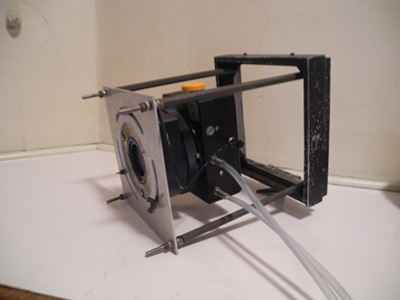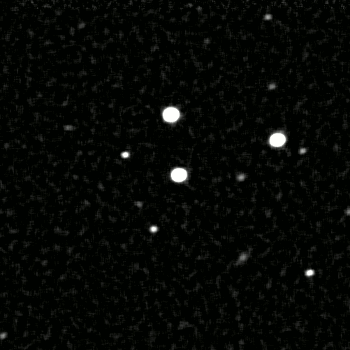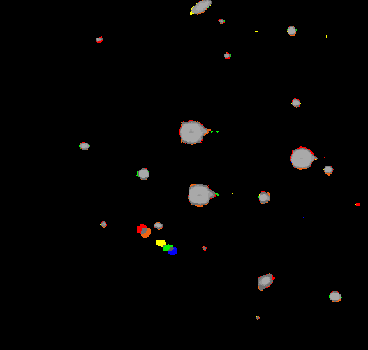Project RUSTICCA
A CCD camera for the Schmidt telescope
The Royal Observatory of Belgium, located in Ukkel, has a long tradition of astrometry, the branch of astronomy that involves the precise measurements of the positions and movements of stars and other celestial bodies. Since the 1920s we systematically observe minor planets at the observatory. A minor planet is an astronomical object in direct orbit around the Sun (or more broadly, any star with a planetary system) that is neither a planet nor exclusively classified as a comet. Minor planets can be dwarf planets, asteroids, trojans, centaurs, Kuiper belt objects, and other trans-Neptunian objects. Before 2006 the International Astronomical Union (IAU) officially used the term minor planet, but during that year's meeting it reclassified minor planets and comets into dwarf planets and small Solar System bodies (SSSBs). A lot of discoveries have been made in Ukkel.
Until the 1990s this was done photographically. With the increasing light pollution in the Brussels agglomeration, however, this became more and more difficult. Additionaly minor planet observations were booming worldwide. The brightest, those that photographically were within the range of our telescopes, became sufficiently known, and observations were scientifically no longer useful. Since the 1980s the astrometric observations of minor planets in Ukkel is at a low level.
"RUSTICCA" stands for "Revalorising the Ukkel Schmidt Telescope by Installing a Ccd CAmera".
A CCD camera is the electronic counterpart of a photographic plate, and contains a light-sensitive chip. The analog signal is converted into a digital image, which can then be processed by a computer. That way, for example, we can subtract the sky background of the image, which enhances the contrast so as to enable the detection of weaker objects. This does not mean that the light nuisance is no longer an issue for the observations. Without the light nuisance we would be able to observe objects that are up to 10 times more faint. A new telescope would therefore never be placed in the center of Brussels, or even near the city.
This project shows that giving an abandoned telescope a new life, doesn't need to be expensive.
In the mid 1990s, a CCD camera was purchased and mounted on the Schmidt telescope at the observatory. Suddenly a new world opened up. From that moment, minor planets could be observed that are up to 200 times weaker than those that were photographically visible to our telescopes. The position measurements were giving results up to 50 times more accurate, performed through software calculations instead of measurements with the eye. Since the fall of 1996, this CCD camera is operational, and the systematic astrometric observations of minor planets has been resumed. The last photographic discovery of a minor planet at the observatory dates back to 1965, so new discoveries were awaiting us.
In the period 1996-2009 some 200 new asteroids were discovered at the observatory. Nowadays asteroids are constantly being discovered around the world. This means that to make new discoveries we constantly have to search for weaker objects. By 2015, the number of yet undiscovered asteroids that can still be observed with the RUSTICCA material became so small that these observations are no longer profitable.
These observations will thus be put on the back burner in the future, and the focus mainly shifted to PHEMUs and PLANOCCULTs.
PHEMU stands for "phenomènes mutuels", meaning mutual coverings and eclipses of the moons (satellites) of Jupiter. Every five to six years the earth and the sun move through the plane of these satellites, effectively covering each other (one satellite moves in front of the other, as seen from earth) and darken (one satellite travels through the shadow of the other).
By doing high speed photometry (ten images per second) of the satellites, we can construct a light curve. Again the objective is to calculate a more precise position of these satellites. So far, there have been observations in 1997, 2003, 2009 and 2014.
PLANOCCULTs are also observed, these are transits of an asteroid in front of a star.
Both stars and asteroids can be seen through a telescope as point sources. But because an asteroid only reflects the sunlight, an asteroid is much darker than a star, which itself emits light. Although an asteroid is usually weaker in light intensity, its apparent diameter can be greater than that of a star, and the asteroid can cover the star completely. The star then becomes invisible for a few seconds. The place on earth where such an occultation will be visible is difficult to determine accurately in advance.
After all, the band on earth where there is coverage is about the same width as the diameter of the asteroid, but the error on its position can be a lot bigger. if an occultation can be observed from different places, the shape of the shadow of the asteroide can be determined, and thus the shape of the asteroid. At the observatory, from 2003 until 2016, about 80 phenomena were seen, and 8 cases of effective coverage were observed from Ukkel.




